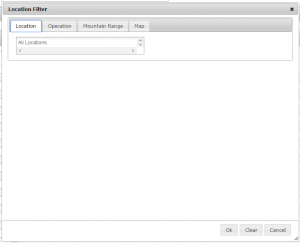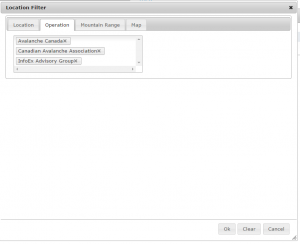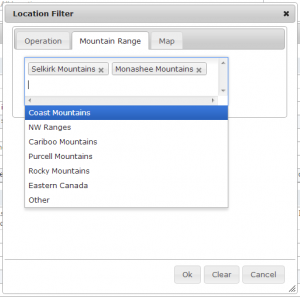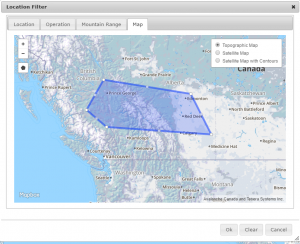Difference between revisions of "Restricting the locations included in an InfoEx report"
Jump to navigation
Jump to search
(→Step-by-step description) |
(→Step-by-step description) |
||
| Line 28: | Line 28: | ||
|class="StepNum" | | |class="StepNum" | | ||
|[[File:ReportTabularViewLocationFilterOperationFilled.png|300px|thumb|right|Fig. 3: Location filter popup window with operation selection]] '''By operations''': | |[[File:ReportTabularViewLocationFilterOperationFilled.png|300px|thumb|right|Fig. 3: Location filter popup window with operation selection]] '''By operations''': | ||
| − | * Click on the {{ButtonGrey|Operation}} at the top of the popup window. | + | * Click on the {{ButtonGrey|Operation}} tab at the top of the popup window. |
* Click into the empty text box and start typing the name of the operation you would like to be included in your report. The dropdown list will automatically list the operations what match with what you type. | * Click into the empty text box and start typing the name of the operation you would like to be included in your report. The dropdown list will automatically list the operations what match with what you type. | ||
* Include as many operations in your report as you like (Fig. 3). | * Include as many operations in your report as you like (Fig. 3). | ||
| Line 35: | Line 35: | ||
|class="StepNum" | | |class="StepNum" | | ||
|[[File:ReportTabularViewLocationFilterMtnRangeFilled.png|300px|thumb|right|Fig. 4: Location filter popup window with mountain range selection]] '''By mountain range''': | |[[File:ReportTabularViewLocationFilterMtnRangeFilled.png|300px|thumb|right|Fig. 4: Location filter popup window with mountain range selection]] '''By mountain range''': | ||
| − | * Click on the {{ButtonGrey|Mountain Range}} at the top of the popup window. | + | * Click on the {{ButtonGrey|Mountain Range}} tab at the top of the popup window. |
* Click into the empty text box and start typing the name of the mountain range you would like to be included in your report. The dropdown list will automatically list the mountain ranges what match with what you type. | * Click into the empty text box and start typing the name of the mountain range you would like to be included in your report. The dropdown list will automatically list the mountain ranges what match with what you type. | ||
* Include as many mountain ranges in your report as you like (Fig. 4). | * Include as many mountain ranges in your report as you like (Fig. 4). | ||
* Click on {{ButtonGrey|Ok}} to submit your selection. | * Click on {{ButtonGrey|Ok}} to submit your selection. | ||
|- | |- | ||
| − | |class="StepNum" | | + | |class="StepNum" | |
| − | | | + | |[[File:ReportTabularViewLocationFilterForecastAreaFilled.png|300px|thumb|right|Fig. 5: Location filter popup window with forecast area selection]] '''By forecast area''': |
| + | * Click on the {{ButtonGrey|Forecast Area}} tab at the top of the popup window. | ||
| + | * Click into the empty text box and start typing the name of the forecast area you would like to be included in your report. The dropdown list will automatically list the forecast areas what match with what you type. | ||
| + | * Include as many forecast areas in your report as you like (Fig. 5). | ||
| + | * Click on {{ButtonGrey|Ok}} to submit your selection. | ||
| + | {{Issue|The CAC forecast areas have not been imported into the system yet|IssueWithImage||}} | ||
| + | |- | ||
| + | |class="StepNum" | | ||
| + | |[[File:ReportTabularViewLocationFilterMapFilled.png|300px|thumb|right|Fig. 6: Location filter popup window with map selection]] '''By custom polygon''': | ||
| + | * Click on the {{ButtonGrey|Map}} tab at the top of the popup window. | ||
| + | * Wait for the Google Earth map to load. | ||
| + | * Navigate to the general location that want to include in your report. | ||
| + | * Click on {{ButtonGrey|Create Polygon}} to create a generic square in the middle of the map. | ||
| + | * Change the shape of the generic square by clicking on the corners and dragging them to the desired location | ||
| + | * Add additional corners to your polygon by clicking on the faint points between corners and dragging them to the desired location. | ||
| + | * Modify the custom polygon until you have the shape you like (Fig. 6). | ||
| + | * Click on {{ButtonGrey|Ok}} to submit your selection. | ||
|- | |- | ||
| − | |class="StepNum" | | + | |class="StepNum" | 4. |
|Wait until the application as retrieved the data for the new date or date range from the server and displays it in the current view. | |Wait until the application as retrieved the data for the new date or date range from the server and displays it in the current view. | ||
|} | |} | ||
Revision as of 13:26, 28 October 2013
| REQUIREMENTS | |
| Permission | All user levels |
| Connectivity | Online only |
This document described how you can restrict the spatial extent of your InfoEx report by specifying what locations to include.
Background
The application offers four possibilities for restricting the locations included in an InfoEx report:
- Selecting the operations to be included
- Specifying the mountain ranges to be included
- Specifying the CAC forecast regions
- Drawing a custom polygon
| NOTE | Please note that the four ways of specifying the locations are mutually exclusive and cannot be combined. In other words you cannot create a report that includes a number of operations and a mountain range. You can only create reports that either contain the observations of a number of operations or within an mountain range. |
Step-by-step description
| 1. | Click into the text box under the 'Location' label of the report view (Fig. 1). | ||
| 2. | This will open a popup window called 'Location Filter' with four tabs across the top (Fig. 2). | ||
| 3. | Use one of the following methods for specifying the locations you would like to be included in your report. | ||
By operations:
| |||
By mountain range:
| |||
File:ReportTabularViewLocationFilterForecastAreaFilled.png Fig. 5: Location filter popup window with forecast area selection
| |||
By custom polygon:
| |||
| 4. | Wait until the application as retrieved the data for the new date or date range from the server and displays it in the current view. |
Related documents
- Link to relate document 1
- Link to relate document 2
Functionality tested by
- Date: Tester / Server / Application version (e.g., Oct. 23: Pascal Haegeli / QA Server / Test Version 0.28.00)




